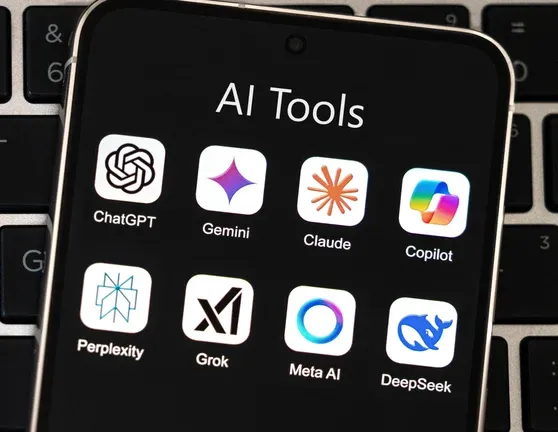Unlocking AI’s Potential: A Step-by-Step Guide for Your Business

Summary: Get your AI Readiness Score and build a scalable, secure AI plan that drives real results. Start with WSI’s step-by-step AI adoption guide today.
As many expert digital marketers and successful business owners will tell you, AI is today’s business advantage. But while the hype is loud, the path forward isn’t always clear. That’s why WSI created this step-by-step AI adoption guide. Whether experimenting with AI tools like ChatGPT, leveraging CRM integrations to enhance customer experience, or utilizing predictive analytics for data-driven decisions, this article breaks down the process step by step—from assessing your readiness to building a secure, scalable implementation plan.
No fluff, no jargon—just practical insights to help your business make smart, confident moves in an AI-driven world.
Let’s get started.
Assessing AI Readiness and Identifying Opportunities
Everyone’s talking about AI like it’s already changed everything. And honestly? It has. But what is the difference between talking about AI and actually using it in your business? That’s the gap where companies get left behind.
If you’re still figuring out how AI fits into your strategy—or even wondering if you need it—you’re not alone. Most businesses are somewhere between “what the heck is prompt engineering?” and “we should be doing something with ChatGPT, right?”
But AI isn’t limited to content creation and conversational tools. For example, AI-powered CRM integrations can automate customer interactions, and predictive analytics can help businesses forecast trends and adjust strategies quickly. AI-driven personalization tools, meanwhile, can tailor content and marketing efforts to specific audiences, driving higher engagement and conversions.
That’s where WSI’s AI Readiness Assessment comes in. It’s 20 quick questions. No jargon. No homework. Just a straight-up snapshot of where your business stands when it comes to adopting AI—and where the most significant opportunities are hiding in plain sight.
Think of it like a flashlight. You get to see the gaps, the strengths, and the low-hanging fruit—all in one score. Maybe you’re ready to automate your lead generation process. Your team may still be trying to understand how to use AI in content creation. Either way, the assessment gives you a starting point that isn’t guesswork.
Because here’s the thing: AI isn’t just some shiny object. It’s becoming the backbone of how businesses operate, market, and grow. Not being ready for it? That’s like not being ready for the internet in 1999.
So take the assessment now. It’s free, fast, and might just tell you more than your last strategy session did.
Developing an AI Implementation Plan
So you’ve dipped a toe into the AI waters. Maybe you’ve played around with ChatGPT. Perhaps you’ve used it to write a blog post or three. You’ve seen the potential. But the real question isn’t if your business should embrace AI—it’s how.
Spoiler: There’s no magic button. But there is a plan.
The Whole-Organization Approach (Because AI Doesn’t Do Silos)
Most businesses start their AI journey the way they start most new things—small. One department, one tool, one experiment. It makes sense on paper. But according to WSI’s Chief AI Officer, Robert Mitchell, it’s a mistake that can stall your momentum.
“The organization must undergo a comprehensive transformation,” Robert said recently on The Art of Franchise Marketing podcast. “Leadership must take the lead in redefining the company’s vision and strategy to integrate AI into the culture.”
Translation: AI isn’t a plugin. It’s a mindset shift.
Because here’s what happens when you optimize just one team—say, marketing—but leave sales, service, and operations in the AI dark: you create brand-new bottlenecks. You move faster in one lane and get stuck in traffic in the others.
AI should touch everything: every role, every workflow, every task. If you’re not thinking holistically, you’re not thinking big enough.
From One-Off Wins to Real Transformation
Sure, AI can help you write better headlines or schedule social posts. But if that’s the extent of your plan, you’re leaving results on the table.
Robert puts it simply: “If you use ChatGPT for the same task more than once a week, that task should be automated.”
Real impact comes from systematic use, not sporadic hacks. At WSI, clients have increased efficiency by 20% after a single AI training session. That’s not hype—it’s survey-backed feedback from actual humans a month after implementation.
For marketing leaders who must manage tight deadlines and budgets, that 20% matters. It means more time for strategy, creativity, and client work and fewer late nights chasing the next caption.
But what about security?
Valid concern.
There’s nothing quite like the combination of excitement and existential dread that comes with sharing sensitive data with an AI tool. And yes, Robert confirms: “The chat logs of language models are hackable, just like your data held by Google or Target.”
Not great.
But there’s a solution: build your own AI environment.
According to Robert, it’s easier than you think to spin up a secure, private language model through a cloud service like AWS or Azure. Without exposing your proprietary data to the broader internet, this gives you control over what the AI sees, stores, and learns from.
This isn’t a “nice to have” for businesses dealing with customer data. It’s essential. Privacy matters. Trust matters. And yes, they’re still possible in an AI-enabled world.
SEO Is Changing. Your Content Should Too.
Let’s talk content. Not the kind that’s written for robots, but the kind that gets found—and actually read.
Traditional SEO used to be about keywords. Sprinkle enough of them into a blog post and watch the clicks roll in. But AI-powered search doesn’t work that way.
“Simply dumping keywords into a blog post won’t work anymore,” Robert says. “Now you need an extensive white paper or a very robust story.”
Why? Because large language models (LLMs) don’t just scan for words—they interpret context, relationships, and semantic relevance. They’re looking for depth. Think of it as writing for a very smart, very picky client.
This approach helps your content grow by connecting ideas, building authority, and delivering meaningful value to your audience. For digital marketers, it’s an opportunity to break free from keyword stuffing and focus on quality storytelling that not only ranks better but also fosters deeper engagement. By creating content that resonates with both AI and humans, you position your brand as a trusted authority, driving sustainable growth and stronger connections with your audience.
High-effort content now delivers high-impact visibility. And that’s a trade worth making.
AI for Busy People (Read: Everyone)
No time? Join the club.
Most business owners and marketing teams are stretched thin. You’re already running on caffeine and “I’ll get to it later.” But here’s the thing: AI isn’t just for people with spare time. It’s for people who don’t have any.
Tools like ChatGPT Plus (yep, it’s $20 a month) come with features like memory, custom instructions, and even the ability to train your own mini-GPTs.
Let’s say you’re managing content for a client. You feed the GPT a few mission statements, tone of voice guidelines, and past social posts—and voilà, you have a copy assistant that knows the brand as well as you do.
It’s not just time-saving. It’s sanity-saving.
When Marketing Becomes AI Consulting
Here’s something that caught us off guard, though it probably shouldn’t have:
“The marketing and AI consulting business models will merge,” Robert predicts.
And he’s right. Clients already expect their agencies and internal marketers to be AI experts. If you’re not, you’re already behind. The overlap is happening whether you’re ready or not.
This means your AI implementation plan can’t be just for internal ops. It has to include a client-facing strategy and be something you offer, not just something you use.
No pressure.
Look, none of this works if you treat AI like a one-and-done thing. It’s not a campaign. It’s not a new tool. It’s an evolving ecosystem.
That’s why continuous learning is baked into WSI’s approach. We don’t do AI workshops to check a box—we do them to spark curiosity, expose gaps, and keep teams moving forward.
If you’re not making time for testing, training, and tweaking your AI systems, you’re not really implementing. You’re just playing with gadgets.
And no, AI doesn’t replace your team. It empowers them. It gives you space to think bigger. To breathe.
Not sure where to start? Treat your AI implementation like you’d treat a new campaign:
- Set clear goals – What are you trying to automate, improve, or unlock?
- Audit your systems – What tools are you already using? What’s manual that shouldn’t be?
- Start small, but think big – Begin with one team or task, but plan for organization-wide adoption.
- Build buy-in from leadership – Without top-down support, your AI plan will stall.
- Create internal champions – People who get it and want to run with it.
- Invest in education – Training, workshops, and real use cases go further than PDFs.
- Measure and iterate – What’s working? What needs adjustment? AI’s power lies in its adaptability.
AI isn’t coming. It’s already here. The gap between businesses that act and those that hesitate is widening every day.
At WSI, we’ve been in the digital marketing space for 30 years. We’ve seen platforms rise, trends fade, and algorithms change overnight. But nothing—nothing—has the potential to change the game like AI.
And the best part? You don’t need to become a coder. You don’t need to understand neural nets. You just need to be curious, committed, and a little uncomfortable.
That’s where growth lives.
Measuring Success and Scaling AI Initiatives
Not every AI initiative is a triumph. Harvard Business School research shows that around 80% of industrial AI projects fail to generate real value. That number should raise eyebrows—and maybe budgets, too. Because when AI fails, it doesn’t just fall flat. It can get expensive.
So, how do you avoid being part of that 80%? You can do this by figuring out what success looks like before rolling anything out. Measuring AI performance isn’t an afterthought—it’s the whole point. If your AI initiative does not align with your business strategy, it is already off course. Technology is not the goal; growth, efficiency, and customer satisfaction are. If utilized correctly, technology serves as a tool to help you achieve these objectives.
Start with a wide lens: identify all possible ways AI could help. Then narrow that list down to:
- A few high-impact, long-term initiatives
- A couple of quick wins (because early confidence matters)
From there, you can track and iterate.
Use these six questions to stay on course:
- Is AI helping us make better decisions?
- Is the organization embracing AI culturally?
- Is AI improving customer experience and value?
- Is AI delivering measurable progress toward goals?
- Are we on time and on budget?
- Are we using AI to support ESG goals (efficiency, diversity, ethics)?
Key Metrics That Actually Matter
Let’s talk KPIs. You need both technical and business-facing metrics to get the full picture:
Business Impact Metrics
- Return on investment (ROI)
- Adoption rate (internal + customer-facing)
- Customer experience (NPS, churn, satisfaction)
- Employee productivity (more strategy, less grunt work)
- Revenue growth from AI-driven initiatives
Operational Metrics
- Processing speed improvements
- Cost savings from automation
- Waste reduction, error rates, and unit costs
AI-Specific Metrics
- Model accuracy (precision, recall, F1 score)
- Bias and fairness scores
- System uptime and reliability
Long-Term Optimization Is the Real MVP
AI isn’t “set and forget.” It’s an ecosystem. You need to monitor, adjust, and evolve. Constantly. Here’s how to ensure long-term optimization of your AI implementation strategy:
Monitor AI Like It’s Mission Critical
- Build real-time dashboards (Datadog, Splunk) to flag issues and track KPIs.
- Retrain models regularly with fresh data (H2O.ai, DataRobot).
- Schedule automated audits for bias, accuracy, and compliance (SHAP, LIME).
Adapt AI to Your Evolving Business
- Expand successful pilots into full-scale functions.
- Use interpretable AI tools to explain decisions (InterpretML).
- Gather feedback from employees, customers, and partners, and use it.
AI can’t succeed in a vacuum. You’re not ready to scale if you don’t know what you’re measuring. Define clear KPIs, align every project with business objectives, and keep optimizing.
Companies that get this right aren’t just “doing AI.” They’re building durable, efficient, scalable systems that create real value.
That’s how you stay out of the 80% club—and remain competitive.
WSI’s Resources and Support for AI Adoption
If you’re a digital marketing agency or business trying to figure out how to use AI without getting crushed by the hype—or worse, a terrible chatbot—you’re in the right place. At WSI, we get it: AI is overwhelming. The tech is evolving daily; everyone’s telling you to use it, but no one’s telling you how. That’s why we’ve built free AI resources designed to meet you wherever you’re at, whether you’re dipping a toe in or already halfway into building custom GPTs.
Start here: WSI’s AI Learning Hub. It’s like a digital backroom filled with practical insights, tools, and guides to help you figure out where AI fits in your business and how to use it to drive results, not just ideas.
Need help understanding what AI can do for your marketing? Or maybe you’re tired of hearing “just use ChatGPT” with zero guidance? Our ChatGPT eBook (5th Edition) breaks down how AI can help real businesses, not just startups, use AI to make their business smarter. The ebook includes practical use cases, tools, and examples to help you work smarter, not harder.
Are you looking for the AI Prompts 101? Then, if you’re ready to make your prompts useful, grab Prompt Mastery: Strategies to Craft AI Prompts That Will Transform Your Business. This isn’t a generic “type better prompts” guide. We’re talking fundamental frameworks, tested examples, and over 50 ready-to-use prompts to save you time, improve your content, and finally make AI do something useful.
Curious what others are doing with AI? We surveyed businesses across industries to see where AI is landing hardest—and where it’s just hype. Our AI Business Insights Report reveals how small and medium-sized businesses are actually leveraging AI to grow. Think of it as a reality check for your strategy.
In banking or finance? We’ve got you, too. Our article on AI for Community Banking dives into how smaller financial institutions can use AI to streamline compliance, planning, and customer experience without taking excessive risks.
Everything we build at WSI starts from a simple principle: if it’s not practical, we don’t publish it. These resources were made by digital marketers for digital marketers, with input from AI experts and business owners who’ve used the tools. Here’s your next step toward successfully integrating AI into your business:
- Start with the AI Readiness Assessment. This will help you assess your team’s preparedness and identify areas where AI can immediately impact.
- Use the assessment results to identify 1–2 low-risk pilots. These initial projects will allow you to experiment with AI without committing significant resources upfront.
- Bring in WSI to help build and scale based on real results. With our expertise, we’ll ensure your AI implementation grows effectively, driving real business outcomes.
Whether you’re trying to pitch AI to a skeptical stakeholder or need to train your team to stop fighting the chatbot and start getting value from it, WSI’s resources are built to support your journey.
AI isn’t magic, but it can be transformative—if you know where to start, what to ask, and how to scale. That’s what we help you do.
The future isn’t about replacing people with AI. It’s about making your people (and your business) unstoppable with it.
Want to go further? Reach out to WSI. We’re here to help you embrace digital—and stay human.
About the Author
Rick spent 20 years in the insurance industry in finance, primarily developing reporting platforms for B & C stakeholders. His ability to speak to consumers of data (managers and analysts) and translate their needs to programmers led him to start his own digital marketing agency in 2004 to develop data driven solutions for business owners.
The Best Digital Marketing Insight and Advice
We are committed to protecting your privacy. For more info, please review our Privacy and Cookie Policies. You may unsubscribe at any time.
Don’t stop the learning now!

Build Once, Grow Often: How Content Pillars Turn Blogs Into ROI

